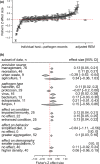Linking anthropogenic resources to wildlife-pathogen dynamics: a review and meta-analysis
- PMID: 25808224
- PMCID: PMC4403965
- DOI: 10.1111/ele.12428
Linking anthropogenic resources to wildlife-pathogen dynamics: a review and meta-analysis
Abstract
Urbanisation and agriculture cause declines for many wildlife, but some species benefit from novel resources, especially food, provided in human-dominated habitats. Resulting shifts in wildlife ecology can alter infectious disease dynamics and create opportunities for cross-species transmission, yet predicting host-pathogen responses to resource provisioning is challenging. Factors enhancing transmission, such as increased aggregation, could be offset by better host immunity due to improved nutrition. Here, we conduct a review and meta-analysis to show that food provisioning results in highly heterogeneous infection outcomes that depend on pathogen type and anthropogenic food source. We also find empirical support for behavioural and immune mechanisms through which human-provided resources alter host exposure and tolerance to pathogens. A review of recent theoretical models of resource provisioning and infection dynamics shows that changes in host contact rates and immunity produce strong non-linear responses in pathogen invasion and prevalence. By integrating results of our meta-analysis back into a theoretical framework, we find provisioning amplifies pathogen invasion under increased host aggregation and tolerance, but reduces transmission if provisioned food decreases dietary exposure to parasites. These results carry implications for wildlife disease management and highlight areas for future work, such as how resource shifts might affect virulence evolution.
Keywords: Aggregation; agriculture; foraging ecology; host-parasite interactions; immune defence; infectious disease ecology; mathematical models; supplemental feeding; urbanisation.
© 2015 The Authors. Ecology Letters published by John Wiley & Sons Ltd and CNRS.
Figures





Similar articles
-
Using host species traits to understand the consequences of resource provisioning for host-parasite interactions.J Anim Ecol. 2018 Mar;87(2):511-525. doi: 10.1111/1365-2656.12765. Epub 2017 Nov 13. J Anim Ecol. 2018. PMID: 29023699 Free PMC article.
-
Food for contagion: synthesis and future directions for studying host-parasite responses to resource shifts in anthropogenic environments.Philos Trans R Soc Lond B Biol Sci. 2018 May 5;373(1745):20170102. doi: 10.1098/rstb.2017.0102. Philos Trans R Soc Lond B Biol Sci. 2018. PMID: 29531154 Free PMC article. Review.
-
Too much of a good thing: resource provisioning alters infectious disease dynamics in wildlife.Biol Lett. 2014 Jul;10(7):20140309. doi: 10.1098/rsbl.2014.0309. Biol Lett. 2014. PMID: 25055815 Free PMC article.
-
Host Dispersal Responses to Resource Supplementation Determine Pathogen Spread in Wildlife Metapopulations.Am Nat. 2018 Oct;192(4):503-517. doi: 10.1086/699477. Epub 2018 Aug 15. Am Nat. 2018. PMID: 30205031
-
Reviewing the effects of food provisioning on wildlife immunity.Philos Trans R Soc Lond B Biol Sci. 2018 May 5;373(1745):20170088. doi: 10.1098/rstb.2017.0088. Philos Trans R Soc Lond B Biol Sci. 2018. PMID: 29531143 Free PMC article. Review.
Cited by
-
In Situ Provisioning Wildlife with Food, Water, or Shelter after Bushfires: Using a One Welfare Framework to Guide Responses.Animals (Basel). 2023 Nov 14;13(22):3518. doi: 10.3390/ani13223518. Animals (Basel). 2023. PMID: 38003136 Free PMC article.
-
Spatial pattern of genetic diversity and selection in the MHC class II DRB of three Neotropical bat species.BMC Evol Biol. 2016 Oct 26;16(1):229. doi: 10.1186/s12862-016-0802-1. BMC Evol Biol. 2016. PMID: 27782798 Free PMC article.
-
The effects of food and parasitism on reproductive performance of a wild rodent.Ecol Evol. 2018 Mar 26;8(8):4162-4172. doi: 10.1002/ece3.3997. eCollection 2018 Apr. Ecol Evol. 2018. PMID: 29721288 Free PMC article.
-
Responses of migratory species and their pathogens to supplemental feeding.Philos Trans R Soc Lond B Biol Sci. 2018 May 5;373(1745):20170094. doi: 10.1098/rstb.2017.0094. Philos Trans R Soc Lond B Biol Sci. 2018. PMID: 29531149 Free PMC article. Review.
-
Making sense of the virome in light of evolution and ecology.Proc Biol Sci. 2025 Apr;292(2044):20250389. doi: 10.1098/rspb.2025.0389. Epub 2025 Apr 2. Proc Biol Sci. 2025. PMID: 40169018 Free PMC article. Review.
References
-
- Altizer S, Hochachka WM. Dhondt AA. Seasonal dynamics of mycoplasmal conjunctivitis in eastern North American house finches. J. Anim. Ecol. 2004;73:309–322. &.
-
- Altizer S, Bartel R. Han BA. Animal migration and infectious disease risk. Science. 2011;331:296–302. &. - PubMed
-
- Anderson RM. May RM. Regulation and stability of host-parasite population interactions: I. Regulatory processes. J. Anim. Ecol. 1978;47:219–247. &.
-
- Anderson RM. May RM. Infectious Diseases of Humans: Dynamics and Control. Oxford: Oxford University Press; 1991. &.
-
- Aponte V, Locke SA, Gentes M-L, Giroux J-F, Marcogliese DJ, McLaughlin D, et al. Effect of habitat use and diet on the gastrointestinal parasite community of an avian omnivore from an urbanized environment. Can. J. Zool. 2014;92:1–8.
Publication types
MeSH terms
Grants and funding
LinkOut - more resources
Full Text Sources
Other Literature Sources

